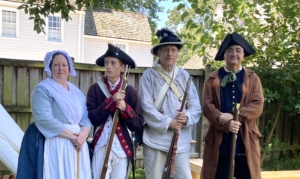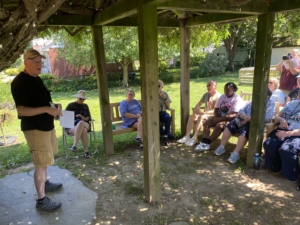
The Arlington Historical Society recently marked the 250th anniversary of the Fairfax Muster one of the first local and statewide militias in the Revolutionary War era.
The living history event was held at the Ball-Sellers House on Saturday, August 9, 2025 to commemorate the establishment of the a statewide militia in Virginia, during August of 1775.
“We can justifiably say the [American] Revolution started here. We were actually the hotbed, the heart, of the American Revolution,” said Kevin Vincent, an amateur historian focused on that period and guest speaker.
Before Arlington became its own county, it was part of Fairfax. During the American Revolution, it was involved in the region’s political and military struggles. Although Arlington was not the site of major Revolutionary battles, the residents of this region contributed significantly to the defense of Virginia, as well as the broader cause of American independence.
When the Virginia Convention met in July 1775, just months after the Revolutionary War started at Lexington and Concord, its first action was to pass a law to raise a defensive force. The new law called for creating a militia, made up of ordinary citizen-soldiers along with regular Continental troops. Every able-bodied free male between 16 and 50 years old, including apprentices and servants, was eligible for local military service. The only people exempt from service were clergy, professors, and government officials. Each Virginia county, including the area now known as Arlington, was required to organize militia companies of 32 to 68 men, led by local officers. The leadership structure extended upward to include a County Lieutenant, Colonel, Lieutenant Colonel, and Major, all appointed by local Committees of Safety.
The militiamen were expected to provide their own gear, both in times of training and combat. Gear typically composed of a musket or rifle, bayonet, tomahawk, powder horn, and cartridge box. They also needed to keep powder and shot at home. Due to many militia men being farmers, laborers, and other lower-class occupations, many companies were poorly equipped.
British traveler Nicholas Cresswell, writing from nearby Alexandria, described 1776 musters where hundreds of Fairfax County men showed up poorly armed, many carrying nothing but sticks. The Fairfax Militia had no standardized uniform. Most wore civilian clothes, though there were efforts to create some consistency. A recommendation was made early on that militia wear hunting shirts as a kind of informal uniform, but this never became common practice.
The Militia’s music and flags played a symbolic role in representing each company’s individuality and spirit. Each company had drummers and fifers, with flags often carrying patriotic slogans like “Virginia for Constitutional Liberty,” along with the county name. Militia training was regular but not as consistent as military training. Companies were required to assemble every two weeks, except during the winter months, and the full county regiment assembled for general musters in April and October. Fairfax, Loudoun, and Prince William counties were grouped into a military district, and their militias were often mobilized together when April and October formations came around.
The Fairfax County militia was called into service at several points during the war. Troops were posted to guard strategic locations such as Alexandria, Mount Vernon, and the port of Colchester. They also helped build defensive works along the Potomac River.
In August 1777, as British General Howe moved troops toward Philadelphia, the Continental Congress requested that one-third of the militia from several northern Virginia counties, including Fairfax, march to support the main army. George Washington personally praised their prompt response in a letter to Colonel William Rumney of Fairfax, noting that their “readiness at this interesting period” was worthy of thanks. Some Fairfax militiamen, including those from present-day Arlington, went on to fight under General Charles Scott at the Battle of Germantown that October.
Militia service resumed in earnest in 1781, as the war shifted back to Virginia. The Governor called up additional troops to support General von Steuben and later to reinforce the Marquis de Lafayette’s forces during the campaign that would culminate at Yorktown. During this time, a portion of the Fairfax militia was kept continuously in the field, with units rotating every two months. Records from this period, including the orderly book of adjutant John Piper, provide valuable insights into daily military life. Copies are preserved today in local public libraries, including those in Fairfax and Prince William Counties.
In addition to the formal militia, Fairfax County was also home to the Fairfax Independent Company, a volunteer unit formed in 1774 by local freeholders and tradesmen. Dressed in striking blue and buff uniforms later adopted by the Continental Army’s general officers, this company elected George Washington as its captain. They trained regularly in Alexandria and made clear their readiness to defend colonial rights. Although disbanded in 1775 when volunteer companies were folded into official militia units, the Independent Company set a strong early example of organized resistance. Their flags bore Latin mottos such as Pro Aris et Focis (“For our Altars and Firesides”) and Aut Liber Aut Nullus (“Either Freedom or Nothing”).
One of Arlington’s most well-known Revolutionary War veterans was John Ball, son of Moses Ball. He fought in the 6th Virginia Regiment, with a rank of Ensign. The 6th Virginia Regiment was raised on December 28, 1775, at Williamsburg, Virginia, for service with the Continental Army. The regiment would see action at the Battle of Trenton, Battle of Princeton, Battle of Brandywine, Battle of Germantown, Battle of Monmouth, and the Siege of Charleston. The regiment was merged into the 2nd Virginia Regiment on May 12, 1779.
John Ball is buried at the Ball Family’s cemetery off of Washington Boulevard. This is one of Arlington’s oldest family burial grounds. Ensign John Ball (1748- 1814), a veteran of the American Revolution (Sixth Virginia Infantry), is buried here. John Ball was the son of Moses Ball, who was one of the pioneer settlers in the Glencarlyn area of Arlington. Also buried in the cemetery are many of John Ball’s direct and collateral descendants, including John Wesley Boldin, a Civil War soldier (Company D, Third Pennsylvania Cavalry), and members of the Marcey. Stricker – Donaldson, and Croson families.


